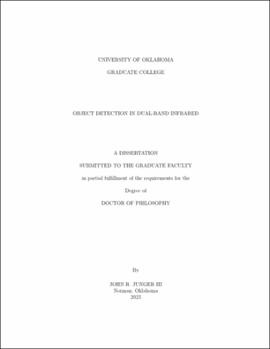| dc.description.abstract | Dual-Band Infrared (DBIR) offers the advantage of combining Mid-Wave Infrared (MWIR) and Long-Wave Infrared (LWIR) within a single field-of-view (FoV). This provides additional information for each spectral band. DBIR camera systems find applications in both military and civilian contexts. This work introduces a novel labeled DBIR dataset that includes civilian vehicles,
aircraft, birds, and people. The dataset is designed for utilization in object detection and tracking algorithms. It comprises 233 objects with tracks spanning up to 1,300 frames, encompassing images in both MW and LW.
This research reviews pertinent literature related to object detection, object detection in the infrared spectrum, and data fusion. Two sets of experiments were conducted using this DBIR dataset: Motion Detection and CNNbased object detection. For motion detection, a parallel implementation of the Visual Background Extractor (ViBe) was developed, employing ConnectedComponents analysis to generate bounding boxes. To assess these bounding boxes, Intersection-over-Union (IoU) calculations were performed. The results demonstrate that DBIR enhances the IoU of bounding boxes in 6.11% of cases within sequences where the camera’s field of view remains stationary. A size analysis reveals ViBe’s effectiveness in detecting small and dim objects within
this dataset.
A subsequent experiment employed You Only Look Once (YOLO) versions 4 and 7 to conduct inference on this dataset, following image preprocessing. The inference models were trained using visible spectrum MS COCO data. The
findings confirm that YOLOv4/7 effectively detect objects within the infrared spectrum in this dataset. An assessment of these CNNs’ performance relative to the size of the detected object highlights the significance of object size in detection capabilities. Notably, DBIR substantially enhances detection capabilities in both YOLOv4 and YOLOv7; however, in the latter case, the number
of False Positive detections increases. Consequently, while DBIR improves the recall of YOLOv4/7, the introduction of DBIR information reduces the precision of YOLOv7.
This study also demonstrates the complementary nature of ViBe and YOLO in their detection capabilities based on object size in this data set. Though this is known prior art, an approach using these two approaches in a hybridized configuration is discussed. ViBe excels in detecting small, distant objects, while YOLO excels in detecting larger, closer objects. The research underscores that DBIR offers multiple advantages over MW or LW alone in modern computer vision algorithms, warranting further research investment. | en_US |

